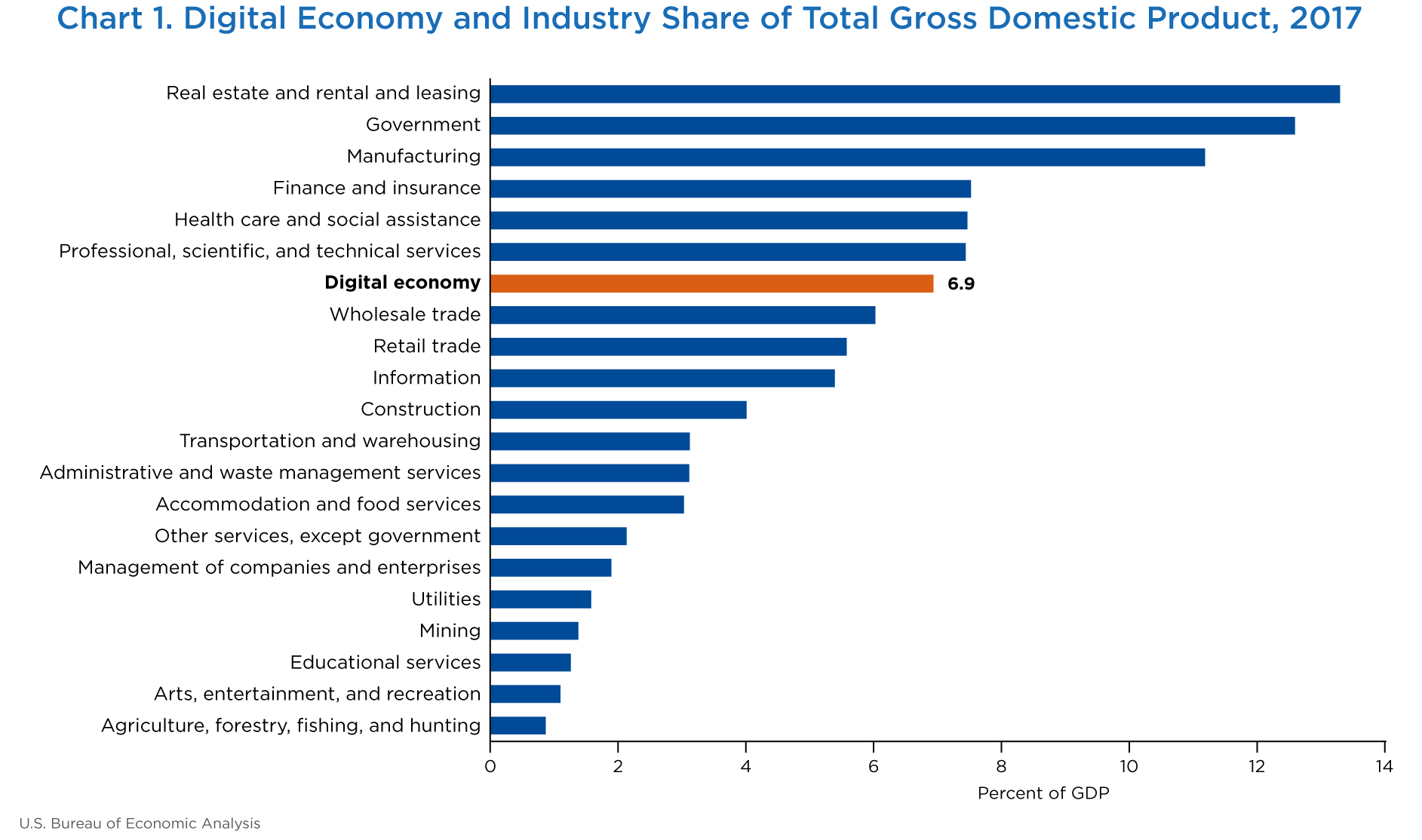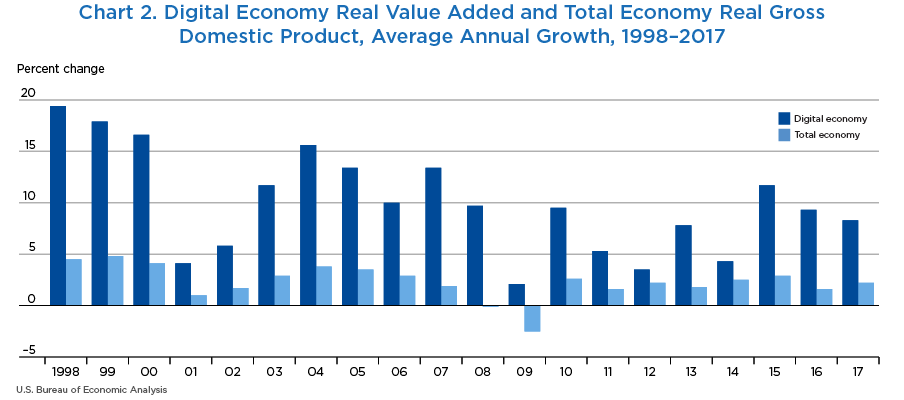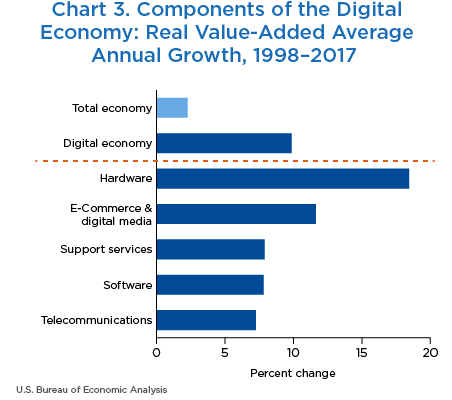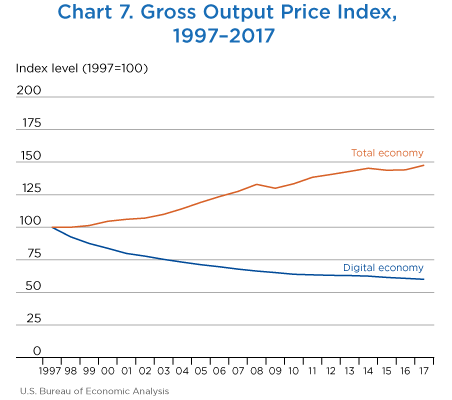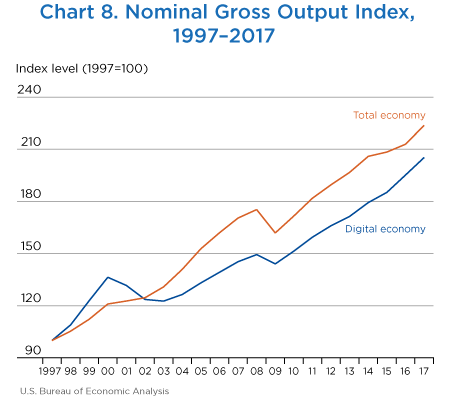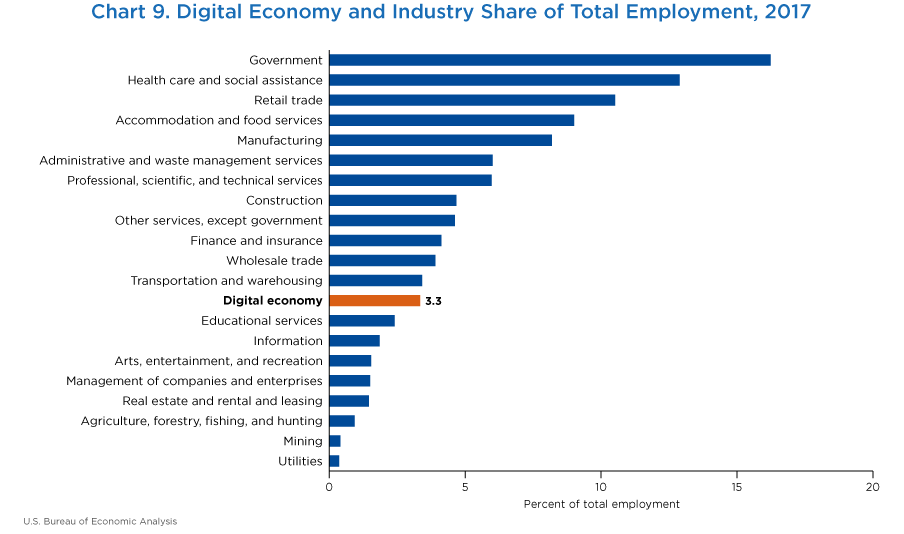Measuring the Digital Economy
In April 2019, the Bureau of Economic Analysis (BEA) released updated measures of the digital economy’s contributions to the overall U.S. economy. The measures include estimates of digital economy gross output, value added, employment, and compensation for the period from 1997 to 2017. The new estimates rely on the same methodology for measuring the digital economy as those used for the initial estimates BEA published in March 2018. The April 2019 update incorporated underlying data revised during the 2018 comprehensive update of the Industry Economic Accounts and expanded the time series.
The March 2018 and April 2019 estimates are BEA’s initial efforts to lay the foundation for a digital economy satellite account and are the first set of estimates within the framework of the national accounts. Conceptually, a digital economy satellite account should include all goods and services related to the digital economy. However, BEA’s measures published to date are based on goods and services that are primarily digital. BEA is researching data and methods to overcome the challenges of measuring “partially digital” goods and services to expand the coverage of the digital economy measures later in 2019.
The updated estimates show the digital economy accounted for 6.9 percent ($1,351.3 billion) of current-dollar gross domestic product (GDP) in 2017, up from 5.9 percent in 1997. Digital economy real value added grew at an average annual rate of 9.9 percent per year from 1998 to 2017, compared to 2.3 percent growth in the overall economy.
BEA developed the digital economy estimates with support from the Commerce Department’s National Telecommunications and Information Administration.
BEA prepared these statistics within the supply‐use framework, following methodology used in the production of BEA satellite accounts, including those on travel and tourism, arts and cultural production, and outdoor recreation.1
The estimation process included three main steps:
- Developing a conceptual definition of the digital economy;
- Identifying goods and services within the supply‐use framework relevant for measuring the digital economy defined in the first step; and
- Using the supply‐use framework to identify the industries responsible for producing these goods and services, and estimate the output, value added, employment, compensation and other variables associated with this activity.
During the second step of this process, BEA reviewed the detailed goods and services categories from the supply‐use framework to identify digital economy goods and services.2 Some goods and services categories include a mix of both digital and nondigital goods and services. For example, the goods category electronic toys and games, including home video games (excluding cartridges, disks, and tapes) includes both digital video games and nondigital electronic toys. Conceptually, measures of the digital economy should include digital video games; however, due to data and resource constraints, the estimates presented here include the goods and services categories that BEA considers primarily digital.
Defining the digital economy
The digital economy is characterized by the rapidly changing nature of technology. Ideally, the definition of the digital economy would allow for the changing nature of what it encompasses over time. Recognizing the large overlap between the information and communications technology (ICT) sector and the digital economy, BEA used its ICT sector as the starting point for measuring the digital economy.3 To aid with identifying additional digital economy goods and services to include in the estimates, BEA relied on analyst expertise and existing digital economy literature and statistics, including work from the Organisation for Economic Co-operation and Development (OECD).4 BEA includes in the digital economy: (1) the digital‐enabling infrastructure needed for a computer network to exist and operate, (2) the digital transactions that take place using that system (“e‐commerce”), and (3) the content that digital economy users create and access (“digital media”).
Identifying digital economy goods and services
Using this definition and the existing detailed data from the supply‐use tables (SUTs), BEA identified goods and services for inclusion in the digital economy estimates. BEA classifies data in the SUTs using a framework that includes about 5,000 categories of goods and services based on the North American Industrial Classification System (NAICS).
BEA selected over 200 goods and services categories for inclusion in the digital economy estimates. The Appendix of the March 2018 working paper “Defining and Measuring the Digital Economy” lists all the goods and services included in the estimates. The goods and services BEA included in the estimates are only a subset of all the goods and services identified in the conceptual definition of the digital economy. As noted in the introduction, some NAICS‐based goods and services categories include digital goods and services as well as nondigital goods and services, or they are only “partially digital.” While BEA’s conceptual definition of the digital economy includes all digital goods and services, BEA included only primarily digital goods and services categories in the estimates.
These estimates serve as the base for future estimates that will also include partially digital goods and services. Including the latter requires additional data and research to split out the portion of the commodity value that is in scope for the digital economy. The last section of this research notes some of the efforts related to measuring partially digital goods and services.
Digital‐enabling infrastructureDigital‐enabling infrastructure is comprised of the basic physical materials and organizational arrangements that support the existence and use of computer networks and the digital economy. Table A describes the sub-components included in digital-enabling infrastructure and indicates BEA’s coverage of the sub-component in the current digital economy estimates.
| Infrastructure sub-component | Sub-component description | Currently included in digital economy estimates? |
|---|---|---|
| Computer hardware | The manufactured physical elements that constitute a computer system, including, but not limited to, monitors, hard drives, semiconductors, wireless communications products, and audio and visual equipment products. | Included almost comprehensively |
| Software | The programs and other operating information used by devices such as personal computers and commercial servers, including both commercial software and software developed in‐house by firms for their own use. | Included almost comprehensively |
| Telecommunications equipment and services | The equipment and services required for the digital transmission of information over a distance by cable, telegraph, telephone, broadcasting, or satellite. | Included almost comprehensively |
| Structures | The construction of buildings where digital economy producers create digital economy goods or supply digital economy services. The structures category also includes buildings that provide support services to digital products. This includes the construction of data centers, semiconductor fabrication plants, the installations of fiber optic cables, switches, repeaters, and so forth. | Not yet included; part of ongoing work |
| Internet of things | Internet‐enabled devices like appliances, machinery, and cars with embedded hardware allowing them to communicate with each other and connect to the internet. | Not yet included; part of ongoing work |
| Support services | Services necessary for the function of digital infrastructure such as digital consulting services and computer repair services. | Included almost comprehensively |
For both structures and internet of things (IoT) infrastructure, BEA does not currently have data available to separate digital economy activity from all other activity. The case of IoT infrastructure presents additional challenges. For example, the connectivity of an internet‐enabled refrigerator may allow the owner to track and purchase food items when they are running low or record usage of the appliance. However, the primary function of the refrigerator is to keep food cold, output which BEA would not classify as being part of the digital economy.
E-commerceBEA uses the term “e‐commerce” to broadly describe all purchases and sales of goods and services that occur over computer networks. E‐commerce reflects the nature of a transaction for goods or services. BEA considers e‐commerce to include digitally ordered, digitally delivered, or platform‐enabled transactions.
E‐commerce output is generally measured as the wholesale or retail trade margin on “digitally ordered” goods and services sold over the internet or through some other electronic market. The margin is equal to total revenue earned from online sales less the producer cost of the goods and services. BEA included in the estimates the margin activity of electronic market establishments and some nonmargin activity as described in table B. For peer-to-peer (P2P) e-commerce, BEA captures the associated transactions, but is currently researching data and methodology to split out the value of this output in scope for the digital economy.
| E-commerce sub-component | Sub-component description | Currently included in digital economy estimates? |
|---|---|---|
| Business-to-business (B2B) e-commerce | E-commerce that utilizes the internet or other electronic means to conduct either intrafirm or interfirm transactions of goods and services by businesses to other businesses. | Includes the margin on B2B wholesale activity from electronic market establishments. Activity from other types of establishments is not included. Also includes nonmargin output for B2B electronic markets. |
| Business-to-consumer (B2C) e-commerce | E-commerce that utilizes the internet or other electronic means to conduct the sale of goods and services by businesses to consumers, also known as retail e-commerce. | Includes the margin on B2C retail activity from electronic market establishments. Activity from other types of establishments is not included. Also includes nonmargin retail trade from electronic auctions. |
| Peer-to-peer e-commerce | The “sharing economy,” or platform-enabled e-commerce, between consumers that involves the exchange of goods and services for a fee and facilitated through a digital application. Includes, but is not limited to, accommodation rentals, transportation/ride-hailing, delivery and courier services, and consumer goods rental. | Not separately identified from traditional industries; part of ongoing work to separately identify within the account. |
Digital media
Increasingly, consumers forgo the physical purchase or rental of products like books, newspapers, music, and videos, opting instead to access these products online in a digital format. BEA defines digital media as the content that people create, access, store, or view on digital devices.
Table C describes how digital media is captured in the BEA digital economy estimates. Only direct-sale digital media is currently included. BEA’s national accounts data does capture the advertising revenue associated with free digital media sites; however, BEA does not currently have the data needed to identify what portion of advertising revenue is associated with these sites.
| Digital media sub-component | Sub-component description | Currently included in digital economy estimates? |
|---|---|---|
| Direct-sale digital media | Businesses may sell digital products to consumers for a fee, either on an item-by-item basis or through a subscription service. | Includes data streaming services (both subscription and one-time purchases of content), internet publishing, and internet broadcasting. |
| “Free” digital media | Some companies offer digital media to consumers at no monetary cost, such as much of the content on YouTube or Facebook. Typically, businesses offering these services earn revenue by selling advertising space on the margins of the digital product. This could also include peer-to-peer digital media produced by consumers for peer consumption. | Not separately identified; part of ongoing work. |
| Big data | Some companies generate large data sets as part of their regular operations. This could also include data on consumer preferences or behavior collected through their use of digital media. Companies may earn revenue by selling this information or leveraging it in other ways. | Not separately identified; part of ongoing work. |
Identifying digital economy industries and preparing results
BEA estimated nominal value added, output, compensation, and employment by industry for the digital economy. After identifying the goods and services included in the digital economy, BEA identified the industries that produce these goods and services using the supply table. Digital economy gross output by industry represents the total value of in‐scope gross output produced by each industry across all digital economy goods and services. Value added for the digital economy is derived from the relationship between the industry output for the digital economy and total industry output. This means the ratio of intermediate consumption associated with the industry output for the digital economy is assumed to be the same as the ratio of total industry intermediate consumption to total industry output. Compensation and employment for the digital economy are derived through the same procedure as value added. Specifically, the ratio of an industry’s digital economy output to total output is applied to total employment and compensation for the industry.
BEA prepared price and quantity indexes for digital economy gross output and value added in three steps. First, gross output indexes are derived by deflating each digital good and service produced by an industry that is included as part of its gross output from the supply table. Second, BEA derived indexes for intermediate inputs by deflating all commodities from the use table that are consumed by the industry as intermediate inputs in the production of digital goods and services. Domestic and international sources of intermediate inputs are deflated separately by using the import proportionality, or comparability, assumption. Third, BEA calculated indexes for value added by industry using the double‐deflation method in which real value added is computed as the difference between real gross output and real intermediate inputs within a Fisher index‐number framework.
Gross domestic product or value added
BEA estimates show the digital economy has been a bright spot in the U.S. economy. GDP is the value of the goods and services produced by the nation’s economy less the value of the goods and services used up in production. GDP by industry, or value added, is a measure of an industry’s contribution to overall GDP. The digital economy accounted for 6.9 percent ($1,351.3 billion) of current‐dollar GDP ($19,485.4 billion) in 2017, up from 5.9 percent in 1997. When compared with traditional U.S. industries or sectors, the digital economy ranked just below professional, scientific, and technical services, which accounted for 7.4 percent ($1,450.0 billion) of current‐dollar GDP, and just above wholesale trade, which accounted for 6.0 percent ($1,174.1 billion) of current‐dollar GDP (chart 1).
In 2017, digital economy real (inflation-adjusted) value added totaled $1,483.5 billion. BEA estimates show the digital economy was an engine of GDP growth throughout the period these statistics cover. From 1998 to 2017, real value added for the digital economy outpaced overall growth in the economy each year and mitigated the downturn in GDP during the recession in 2008 and 2009 (chart 2). Excluding the recessionary years of 2008 and 2009, digital economy real value-added, year-over-year growth for this period was on average four times higher than total GDP growth. Digital economy real value added grew at an average annual rate of 9.9 percent per year from 1998 to 2017, compared to 2.3 percent growth in the overall economy.
The relative strength of the digital economy led it to consistently contribute more to economic growth than its share of the economy. For example, in 2017, the digital economy accounted for just 6.9 percent of the economy; however, real value-added growth of 8.3 percent in the digital economy accounted for 25 percent, or 0.55 percentage point, of the total 2.2 percent growth in real GDP.
Over the entire 1998 to 2017 period, the digital economy experienced real value-added average annual growth of 9.9 percent, compared to 2.3 percent for the total economy (chart 3). Within the digital economy, the hardware component grew the fastest, with 18.4 percent average annual growth over the period. However, the growth rate in hardware varied notably between the beginning and end of the period measured, ranging from 33.6 percent average annual growth between 1998 and 2007, down to 5.0 percent average annual growth from 2008 to 2017. While hardware grew the fastest over the period from 1998 to 2017, growth slowed to only 5.0 percent at an average annual rate in the most recent decade, the slowest of any digital economy component.
Software and telecommunications exhibited slower average annual growth in the more recent years, but to a much lesser extent, with average annual growth falling about 4 percentage points between the first and second decades in the time series for both components. For software, growth fell from 9.9 percent average annual growth from 1998 to 2007 to 5.8 percent from 2008 to 2017, while telecommunications fell from 9.4 percent to 5.2 percent over the same period. E-commerce and digital media exhibited more stable average annual growth (12.2 percent from 1998 to 2007 and 11.1 percent from 2008 to 2017). Support services was the only component that grew faster during the second half of the period, with average annual growth of 7.0 percent from 1998 to 2007 and 8.8 percent from 2008 to 2017.
Overall, average annual growth of 18.9 percent in real value added of digital goods outpaced digital services, which measured 7.7 percent. In the later decade, from 2008 to 2017, the average annual growth rates for digital goods and digital services were more aligned at 8.0 percent and 6.9 percent, respectively.
From 1997 to 2017, digital economy current-dollar value added accounted for an average of 6.1 percent of total U.S. current-dollar GDP each year (chart 4). The digital economy share of total GDP has generally been rising, and in 2017, it accounted for 6.9 percent of the total economy, the highest share over this time span. In this year, digital economy current-dollar value added totaled $1,351.3 billion.
In current dollars, digital economy value added decreased in 2001; this was the only year in the series in which year-over-year, current-dollar growth was negative. From 1998 to 2001, digital economy prices rapidly decreased. The value-added price index fell by 7.3 percent from 2000 to 2001, with the index for hardware falling by 33.9 percent as the quality of computer hardware increased rapidly.
In 1997, digital-enabling infrastructure, or the hardware, software, telecommunications, and support services that comprise the digital economy, accounted for 95.0 percent ($480.1 billion) of digital economy current-dollar total value added ($505.3 billion) (chart 5). In 2017, digital‐enabling infrastructure accounted for $1,143.4 billion (84.6 percent) of the total estimated $1,351.3 billion in digital economy current‐dollar value added. E-commerce and digital media grew from accounting for just 5.0 percent ($25.2 billion) of the digital economy to 15.4 percent ($207.8 billion) over the 20-year timespan.
While e-commerce and digital media became a larger share of digital economy current-dollar value added, there were also shifts in the composition of the components that make up digital-enabling infrastructure. In 1997, telecommunications accounted for 40.7 percent ($205.5 billion) of total digital economy current-dollar value added. By 2017, telecommunications current-dollar value added had grown to $339.6 billion, but its share of the overall digital economy had fallen to 25.1 percent. Hardware declined in its total value and in its contribution to digital economy current-dollar value added, accounting for 19.8 percent ($100.3 billion) of the total in 1997 and just 7.1 percent ($96.3 billion) in 2017. Support services and software, the other two components of digital-enabling infrastructure, contributed more to digital economy current-dollar value added in 2017 compared to 1997, growing from 23.1 percent to 34.7 percent and 11.4 percent to 17.7 percent, respectively.
Gross output
Gross output is a measure of sales or revenue from production for most industries. Real gross output for the digital economy grew at an annual rate of 6.3 percent from 1998 to 2017, faster than the total economy, which grew at an average annual rate of 2.1 percent. The compound effect of the faster output growth in the digital economy relative to the overall economy is clearly seen when output is indexed to a base year (chart 6). Since the end of the most recent recession, the output growth from the digital economy has continued to outpace the overall economy. Since 2010, digital economy real gross output growth averaged 2.5 percent per year and outpaced average annual real gross output growth of 1.0 percent in the overall U.S. economy, widening the distance between the gross output indexes displayed in chart 6.
During this period of economic recovery, prices for digital economy goods and services decreased at an average annual rate of 1.0 percent (chart 7). Prices for all goods and services in the economy increased at an average annual rate of 1.6 percent.
Although real output in the digital economy accelerated faster than real output for the economy overall, the falling prices of digital goods and services caused current‐dollar gross output growth in the digital economy and the overall economy to track much closer (chart 8). Digital economy nominal gross output reached $2.05 trillion in 2017, totaling 6.0 percent of total U.S. nominal gross output.
Employment and compensation
In 2017, the digital economy supported 5.1 million jobs, which accounted for 3.3 percent of total U.S. employment (152.1 million jobs), comparable to the transportation and warehousing industry (chart 9). Employees working in the digital economy earned $132,223 in average annual compensation compared to $68,506 average annual compensation per worker for the total U.S. economy.
BEA is working to expand the coverage of the digital economy estimates to include additional e-commerce activity and selected partially digital commodities. The feasibility of expanding the coverage is conditional on data availability. BEA is also exploring data and methodologies to include activities of digital intermediaries, such as ride-hailing activity. At this time, cloud computing estimates are fully included in BEA digital economy estimates but are not a separate line item, like hardware or software. Some of the NAICS-based services categories include output related to cloud computing services as well as unrelated output. BEA needs additional data to estimate the relevant portions to separately value clould computing in the digital economy estimates.
BEA actively participates in OECD meetings on developing digital SUTs with the continued goal of implementing international guidance on measuring the digital economy. BEA will align its digital economy measures to international standards to the extent possible. BEA is assessing the feasibility of publishing a complete set of SUTs for the digital economy in late 2019.
- For more information on the methodology and satellite accounts, see “Measuring the Nation’s Economy: An Industry Perspective. A Primer on BEA’s Industry Accounts&rquo;. The industry accounts are one component of the U.S. economic accounts that provide information on the value and composition of output produced in the United States and on the types of income generated.
- BEA classifies goods and services using a system based on the North American Industrial Classification System.
- The BEA ICT sector consists of computer and electronic product manufacturing (excluding navigational, measuring, electromedical, and control instruments manufacturing); software publishers; broadcasting and telecommunications; data processing, hosting, and related services; internet publishing and broadcasting and web search portals; and computer systems design and related services. BEA’s definition is generally consistent with the internationally accepted definition of the ICT sector used and developed by the statistical offices of the Organisation for Economic Co-operation and Development and United Nations.
- For information on the OECD’s digital economy measurement work, see http://www.oecd.org/sti/ieconomy/. BEA also participates in the OECD working group on Measuring GDP in a Digitalized Economy.
